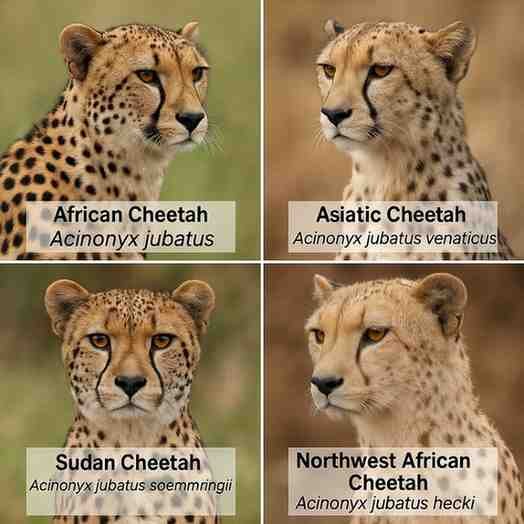What is the scientific name of the cheetah? The Cheetah scientific name is Acinonyx jubatus.
Regarding terrestrial animals, there is no contest that the cheetah is the fastest. Slender in build, the cheetah can sprint away, leaving other animals in its wake. However, there is more to learn about cheetahs, their scientific name, species, classification, pronunciation, meaning, and biology. This complete article covers everything you need to know about the cheetah’s scientific name, including origin, taxonomy, and place in the animal kingdom.
Table of Contents
What is a Scientific Name For a Cheetah?
Acinonyx jubatus is the scientific name of the cheetah. This name is universally recognized in the scientific world to identify the cheetah. It enables differentiation between scientifically accurate and true scientific names and those offered through local or common sources.
Cheetah’s full scientific name:
- Genus: Acinonyx
- Species: jubatus
- Zoological family: Felidae (cat family)
If someone were to ask what the scientific name cheetah is, then the answer would always be Acinonyx jubatus.
Zoological Classification Of Cheetah
| Taxonomic Rank | Classification |
|---|---|
| Kingdom | Animalia |
| Phylum | Chordata |
| Class | Mammalia |
| Order | Carnivora |
| Family | Felidae |
| Genus | Acinonyx |
| Species | jubatus |
This zoological and biological classification shows how the cheetah fits into the animal kingdom.
Meaning of the Cheetah Scientific Name
The cheetah’s scientific name has been given a meaning that has its roots in Latin and Greek:
- Acinonyx comes from Greek, where “Akinetos” means un-moving or stable, and “onyx” refers to the claw. Thus, Acinonyx signifies the non-retractable claws of the cheetah.
- Jubatus is a Latin word whose meaning in English is “maned” or “crested,” referring to the mane-like fur found in juvenile cheetahs.
Therefore, the entire biological name of the cheetah, Acinonyx jubatus, highlights two features: its claws and its fur.
Pronunciations of the Scientific Names of Cheetahs
Knowing the pronunciation of cheetah scientific names is handy in schools, studies, and class discussions. Here is how to pronounce it:
Acinonyx jubatus pronunciation is like:
- /ˈæsɪnənɪks ˈdʒuːbətəs/
Break it down to English:
- Acinonyx: ASS-ih-no-niks
- Jubatus: JOO-buh-tus
Using the cheetah scientific name pronounced in the right way highlights the respect and knowledge of an individual’s understanding of scientifically used words.
Cheetah Sound: What Does a Cheetah Sound Like?
Unlike lions and tigers, the cheetah does not roar. Thus, it has its unique sounds, as below:
- Cub call: This is a highly pitched sound meant to call the specific cubs.
- Purr: This sound refers to a soft, pleasant sound made in a relaxed state.
- Hiss: A type of sound expressed in a threatening way.
- Growl: This is a deeper sound made in the course of fighting.
Despite the cheetah scientific name being about classification, sounds are also an important characteristic for the identification and understanding of the animal.
Genus of the Cheetah
The cheetah belongs to the genus Acinonyx. Hence, it remains an uncommon big cat because there is only one species in this genus Cheetah.
In addition, cheetahs are the only large cats without fully retracting claws. A feature responsible for both their speed and their name, one that means unstable claws in Greek, Acinonyx.
So whenever you happen to read or hear the scientific name of the cheetah, it speaks more than just a name. It tells something about the animal’s body and characteristics.
Types of Cheetahs and Subspecies

A few subspecies of cheetahs are recognized. They all have the same basic scientific name, “cheetah,” with minor variations:
1. Southeast African Cheetah:
- Scientific name: Acinonyx jubatus jubatus
- Mostly found in South Africa and Namibia.
2. Northeast African Cheetah
- Scientific name: Acinonyx jubatus soemmeringii
- Found in Ethiopia and Sudan.
3. Asiatic Cheetah:
- Scientific name: Acinonyx jubatus venaticus
- Formerly extended throughout Asia, but now exists only as critically endangered in Iran.
4. Northwest African Cheetah:
- Scientific name: Acinonyx jubatus hecki
- A rare subspecies inhabiting parts of North and West Africa.
Regardless of the differences, they share the same biological name of the cheetah root and belong to the same genus, Acinonyx.
Cheetah Facts Table: Height, Weight, Speed, Diet, Sound, and Habitat
| Fact | Details |
|---|---|
| Scientific Name | Acinonyx jubatus |
| Height | 70–90 cm at the shoulder |
| Weight | 21–72 kg |
| Speed | Up to 112 km/h (70 mph) |
| Diet | Carnivore (mainly gazelles and small antelopes) |
| Sound | Chirps, growls, hisses (does not roar) |
| Found In | Sub-Saharan Africa, parts of Iran |
| Lifespan | 10–12 years (wild), up to 17 years (captivity) |
| Conservation Status | Vulnerable (IUCN Red List) |

